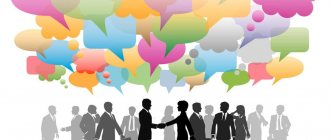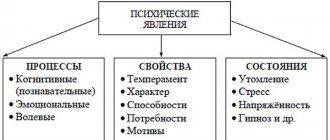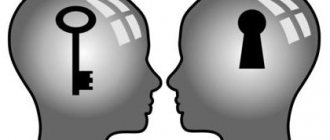Reactivity is one of the main properties of temperament. A person’s behavior in various situations depends on this quality. How do you make decisions: spontaneously, based on emotions, or after careful consideration? The answer to this question will show how developed your reactivity is and whether you can cope with unforeseen situations.
Temperament as perceived by philosophers and scientists of antiquity
Even ancient philosophers argued that a person has a number of characteristics given to him at birth, which are subsequently formed into a set of traits or so-called character. It is impossible to significantly change these features; they can only be easily adjusted under the influence of society and education.
Scientists of that time could not imagine what temperament or character depended on, but they made attempts to substantiate their numerous theories in proportion to knowledge in medicine and psychology. The founder of the typology of temperaments was Hippocrates; he was the first to define each of the types that are still used today. But the famous doctor explained temperament by the predominance of one or another liquid in the human body.
Years later, European scientists tried to put forward their own typology based on the physical characteristics of people. This version was subject to much criticism in the scientific world and is now practically not used.
Types of burnout
There are 4 types of burnout based on their structure: one-factor, two-factor, three-factor, four-factor.
Single factor burnout
The main factor is exhaustion (emotional, cognitive, physical). The remaining components (depersonalization and reduction) are a consequence. All professions are susceptible to this type of burnout, not just social ones.
Two-factor burnout
The influence is exerted by exhaustion (affective factor) and depersonalization (attitude factor). This type is more typical of social professions, but not necessarily (if depersonalization occurs in relation to the person himself, and not others).
Three-factor burnout
All three factors have an influence (exhaustion, depersonalization, devaluation). Exhaustion is manifested by a reduced emotional background, oversaturation of contacts or indifference. Depersonalization can manifest itself in two ways: dependency in relationships or negativism and cynicism. Devaluation affects either professional self-esteem or personal self-esteem. This type of burnout is typical of social professions.
Four-factor burnout
With this type, any factor (exhaustion, depersonalization, reduction) is divided into two more. For example, there is an immediate devaluation of the subject of labor and clients.
Temperament through the eyes of Hippocrates and Claudius Galen
Hippocrates defined personality temperaments, and his student and follower Claudius Galen wrote a large scientific treatise, where he described each type in detail and detail, specifying the liquid that is contained in the maximum quantity in human organs.
Based on Galen's theory, there were the following types of human temperament:
- sanguine - this person had a large amount of blood, which influenced his actions and emotions;
- phlegmatic - he was the result of the predominance of phlegm;
- choleric - had increased bile content;
- melancholic - suffered from an abundance of black bile in the body, corroding his internal organs.
Almost until the eighteenth century, this theory was perceived as the only correct one. And only the hard work of modern scientists dispelled the fantastic assumptions of Hippocrates, although the names and characteristics of temperaments have remained unchanged and are actively used.
What do you need to do to accustom yourself to a proactive model of behavior?
N.F.:
In order to start using proactive behavior in your life, first of all, you need to realize that there is reactive and proactive behavior, and there is a difference between them. Next, you need to consciously monitor your behavior pattern: how I react to a sudden situation. If my reaction does not help me, it is reactive behavior. How long does it last, and what do I need to do to become proactive? In fact, proactive behavior is the conscious management of your reaction to events.
Therefore, first, it seems to me, you need to understand the difference between reactive and proactive behavior, then understand what questions you need to ask yourself in order to switch to proactive behavior, and only then learn to see the opportunities that are hidden in every situation that arises.
Division into temperaments in modern psychology
Academician Pavlov made a great contribution to the development of psychology. As a result of research, he found out that a person from birth has his own type of nervous system, which determines his behavior. Moreover, this theory is equally effective for animals and people. Subsequently, Pavlov’s research became the basis for the work of Soviet and European psychologists. As a result, a scientifically based typology of human temperaments emerged:
- Sanguine. People of this temperament easily adapt to new conditions, are active and efficient. Most of them are friendly and have high communication skills. They are sensitive to the mood of others and are extroverts.
- Choleric. This temperament characterizes irritable and hot-tempered people. They get distracted from their work very quickly and find it difficult to concentrate. The expression of emotions in choleric people is violent and short-lived; they can also be considered extroverts.
- Phlegmatic person. Such people are very efficient, but it is difficult to switch from one thing to another. They are little emotional and are able to remain calm in any situation. All their movements are slightly slowed down, the same goes for facial expressions. Phlegmatic people are classified as introverts.
- Melancholic. Melancholic people are very sensitive, but not too active. They are touchy, but timid and inhibited. Such people have low productivity and have difficulty meeting new people. The slightest trouble causes violent emotions in them, paralyzing any activity.
To determine a person's temperament, it is necessary to consider him in relation to a number of properties. Psychology has a productive system that allows you to analyze the type of nervous system and classify it.
Proactive or reactive: test
Proactive/reactive attitude is easily assessed using a simple test. In it you need to select phrases that a person uses in different situations.
You need to try on both options and choose your preferred one. And evaluate the results.
You should not strive to choose those combinations that never flash in your head or sound out loud. This is not true. And it won’t help to give a true definition of the type of behavior.
| Proactive | Reactive |
| I will strive to change this | It's unlikely that anything can be done about this |
| I'll change their minds | It is unlikely that they will be convinced |
| I don't really like the people I work with, but not so much that I take it personally | My colleagues annoy me |
| I go to work | I have to go to work |
| I decided that I would do just that | I have to do this because... |
| I will find time to devote to these matters | I would help, but I don't have time |
| I'll figure out where to find funds to start the project | I have limited financial resources and will not be able to start this project. |
| It’s strange that few people are interested in this; what can be done to make it beneficial? | Nobody needs this, well, I won’t do anything |
| I need connections. I'll figure out where to find them | Certain connections are needed here. I do not have them |
| I will prove that no one can do this job better than me. | I won't be trusted with this job |
What if there are “reactive” phrases in the list?
Work with it.
There is a simple algorithm for increasing proactivity, and if you follow it, you can achieve a lot.
Basic properties of temperament
Defining temperament is impossible without eight aspects that characterize it:
- sensitivity;
- activity;
- ratio of reactivity and activity;
- plasticity and rigidity;
- reaction rate;
- emotional excitability;
- extroversion or introversion.
An experienced psychologist assesses the personality for each aspect and determines the type of temperament. The most important parameters are considered to be reactivity and activity. It’s worth talking about them in more detail.
Reactivity in psychology: definition
It is difficult to say when psychology became a serious science and began to consider a person’s personality taking into account all aspects of temperament. But the scientific community believes that Wolf Solomonovich Merlin was the first to introduce such a concept as reactivity in psychology. This gave impetus to further research into the psycho-emotional differences of individuals, which eventually resulted in a fundamental scientific theory.
At the moment, it can be argued that reactivity in psychology is the uncontrolled reactions of an individual to any stimuli of an external and internal nature. The intensity and duration of these reactions largely determine a person’s temperament. Subsequently, psychologists came to the conclusion that emotional reactivity is responsible for performance and productivity. In psychology, this has acquired particular importance; many large corporations in the West use the concept of reactivity when selecting new personnel.
How to change your thinking
For many, it will be interesting to learn how to develop positive thinking, what specific steps are needed and their sequence. There are several rules of proactivity:
- In any circumstances, focus on looking for opportunities to correct the situation.
- Make active efforts instead of consoling yourself and looking for blame in unfavorable environmental factors.
- In a difficult situation, look for any available opportunities to influence its positive resolution.
It is impossible to change your habitual behavior in a short period of time. Constant effort is required, the main thing is to decide to take the first step. Over time, the habit of asking yourself the question: “What can I do?” will become permanent, not requiring special efforts. The desire to improve life cannot be achieved without changing your attitude towards it.
A position where a person considers those around him and unfavorable conditions to be to blame for his failures does not imply active actions to change what is happening. This is an easy path, but it will not lead you to success. This is the choice of weak individuals who find it easier to cry into their vests and reproach everyone around them than to take the necessary steps to change their lives.
Features of different types of thinking:
| Jet | Proactive | |
| Attitude to what is happening | Low self-esteem Þ dependence on events | Self-confidence Þ desire for change |
| Negative reaction | Positive reaction | |
| It's my fault; It doesn't depend on me; If not for this | I will do; I am responsible for everything myself; I'll make a decision | |
| Circle of influence | Energy is spent on a range of concerns: complaints, accusations, pressure on people | Focusing on finding reasons within oneself: personal responsibility, actively changing the situation |
| Energy | Negative, destructive | Positive, creative |
| Life role | Victim, Slave | Creator, leader |
| Finance | Poor | Rich |
| Creation | User, dependence on other people's opinions | Idea's generator |
Reactivity and speed of decision making: is there a relationship?
Based on the results of numerous studies and tests, psychologists have found that the speed of decision-making and reactions to various life situations depends on reactivity.
People with high reactivity often make decisions under the influence of emotions and the moment; many of their conclusions and reactions are incorrect. But in a critical situation, they can save the life of not only one person, but also many others. The same cannot be said about individuals with low reactivity. They think about every decision for a long time and are not able to make it at a specific moment under the influence of stimuli from the outside world.
Why is proactivity needed?
Proactivity in business and at work will seriously increase your results; proactivity in life will lead you to success. Going with the flow is much easier than fighting, but only in fighting can you achieve what you want and turn your dreams into reality. Proactivity is not the key to success; without this quality, many people who had talents and abilities remained unknown, simply because they waited for everything to happen by itself.
At work, a proactive employee is a great value and it is worth holding on to and developing them. As a rule, proactivity is laid down during upbringing, even in childhood, but there are people who changed their attitude towards the world in adulthood.
Formula for Reaction Intensity in Emotional Reactivity
Since reactivity in psychology is a reaction to an external stimulus, it would be natural to assume that it has a certain strength. In the modern world, there is even a formula according to which you can determine the degree and intensity of the reaction.
In people with low reactivity, intensity is in direct interaction with the strength of the impact. The more pressure you put on such a person, the more intense his reaction.
Otherwise, everything happens to people who are easily excitable. The intensity of their reaction is absolutely independent of the strength of the impact. Even slight pressure triggers an intense reaction in the individual. This makes highly reactive people unpredictable and difficult to manage.
Instead of output
The essence of a proactive and reactive approach to life is clear.
Some act.
The second ones groan.
There is no need to comment on who achieves the goal.
All that remains is to decide which path is yours. And give examples of your own proactive and reactive behavior, if you manage to catch them in current affairs. Simple analysis, but will it work? Write in the comments.
Interesting read:
Rules for success in life and business: 12 secrets of successful people
Methods and methods of self-motivation: 8 ways to effectively self-motivate
Feng Shui wish map for 2021: when is the best time to do it and how to draw it up correctly
Reactivity in psychology: examples of manifestation in everyday life
In order to have a complete understanding of reactivity, let's give a simple real-life example. Let's say you're dreaming of a vacation after a hard year of work. Your friends are also going to relax, but one goes to the mountains, and the other dreams of a lazy beach holiday in a warm country. Both of them invite you to come with them, but after much deliberation you decide to go on a trip to the sea and the sun. At that moment, when you are ready to voice your decision to a friend, he begins to argue that you must go with him and have no right to do otherwise. This is where your reactivity matters a lot. What will you do? Will you begin to resist the pressure and abandon your already planned and much-desired vacation on the beach, going to the mountains as a protest? Or stick to the original plan, no matter the pressure put on you?
People who are capable of doing harm to themselves are characterized by increased reactivity and often draw the wrong conclusions from the situation. Moreover, the opponent’s personality does not play a role in making a decision; it can be a close friend or a stranger. A tendency to make hasty and incorrect decisions is revealed in those people who have increased reactivity. In psychology, this is considered to be a constant, which is used as a starting point in determining a person’s temperament.
How to find out your thinking type
- health status;
- Job;
- children and relatives;
- weather;
- events from the past;
- safety.
He called these groups a circle of concern and influence. Everything that can influence emotions and mood conventionally belongs to the first group. This is a set of circumstances that have to be taken into account, but cannot be influenced. Examples: weather, relationships with superiors, situation in the country, politics. The second group includes what can be changed. Examples: you can stop communicating with an unpleasant person, stop watching time-consuming TV shows.
It is necessary to analyze which of the two circles is given more time and effort. Proactive individuals tend to focus their efforts on their circle of influence. They are not afraid to take on obligations and responsibilities, and look for optimal ways to solve complex issues. This allows you to constantly increase your potential and become attractive in the eyes of others.
Reactive people pay more attention to their range of concerns. They are irritated by the weaknesses and bad habits of others, problems and circumstances that cannot be changed now. They tend to complain and blame others for their failures and feel like innocent sufferers. The negative energy they generate and their disregard for those issues that can be resolved within their power lead to a gradual contraction of the circle of influence. This entails increased dependence on external circumstances. Reactive thinking causes you to focus your attention on the circle of concerns and become dependent on what is inside it.
A simple test will help you find out how to determine your type of thinking. You need to select from the table the saying with which you agreed and then calculate which part contained more of them.
| Proactive | Reactive |
| I'll try to change the situation | There is most likely nothing that can be done about this. |
| I have enough arguments to defend my opinion | You can't convince people |
| Colleagues don't inspire respect, but that doesn't bother me | People I work with irritate me |
| Going to work | Forced to work |
| I made a decision; I know what to do | I have to; I'm forced to do this because |
| I will be able to find time for my favorite activity | I don't have enough free time |
| I will find a way out of a difficult situation | Circumstances are stronger than me, I can’t |
| What can you do to benefit? | I won’t do anything, no one needs it |
| I will be able to find the right people and make useful connections. | This requires connections that I don't have. |
| I can do the best job | I will never be trusted with a responsible project |
If there are several matches with the reactive column, you will have to work to get rid of the negative type of thinking. For success in professional activity, it is valuable to change thoughts and speech in a proactive direction. This is a prerequisite for switching to a different way of perceiving the world. Many wealthy people have faced failures, collapse of plans, and bankruptcy several times in their lives. Thanks to a positive attitude and self-confidence, they managed to achieve success despite the most unfavorable conditions.
Reactivity and activity: features of the relationship
It has long been proven that the productivity of any human activity is determined by the ratio of reactivity and activity. In psychology, this was expressed in several formulas that emerged as a result of special and lengthy research. Highly reactive individuals have little activity, since they cannot work with concentration and are constantly distracted by the slightest external stimuli. In addition, this type is also affected by internal stimuli - thoughts, emotions, memories. All this significantly reduces labor productivity.
Individuals with low reactivity usually have the highest activity. They are able to solve one problem until a result is achieved, without being distracted by anything in the world around them. Such people are able to work for weeks and months until they get what they want. Scientists who have given the world great discoveries are often classified as this type.
The psychological reactions of many people cannot be controlled, but with certain knowledge, it is possible to predict a person’s behavior and draw conclusions about his capabilities on the way to the top of his career.
Development of proactivity
There is a way to change your thinking, but you will have to make an effort, since tangible results will only appear after a certain time. There are no exact dates, since everything depends on the efforts made by the person. Stages:
Pay attention to signs of reactivity
.
If you find yourself in an unpleasant situation, do not get angry and react violently.
Try to understand the reason for the event that happened; it is probably not your fault or someone else’s. Example: I had to lose time in line. Your irritation will not change the situation, so you should not criticize the current circumstances. Change your way of thinking.
Directly depends on the words and thoughts used. We will have to abandon the phrases “I can’t”, “If only”, replacing them with “I can”, “I will do”. As soon as a negative thought appears, immediately replace it with a positive one. Over time, a positive attitude will become a habit.
Analyze previous mistakes
.
The past cannot be changed, but often unpleasant events from it remain in the memory for a long time, forcing us to relive what happened.
The rational approach is to understand the cause of the error and draw the right conclusions. This will prevent similar events from happening again in the future. Don't avoid responsibility
.
Making a commitment forces the brain to work hard to achieve a goal, regardless of the obstacles that arise. It's difficult, but in the end everything pays off in the form of material benefits and the respect of others.











